Report on Tesco's Website Design and Social Media Marketing Strategies
VerifiedAdded on 2021/02/19
|8
|2607
|19
Report
AI Summary
This report provides a detailed analysis of Tesco's marketing strategies, focusing on its website design and social media activities. It begins with a short introduction to Tesco, highlighting its history and core values, followed by an examination of its target audience, which has evolved to include single-person households and the elderly. The report then delves into an analysis of Tesco's website using Website Design Theory, evaluating its layout, color schemes, and customer-friendly interface. It discusses the challenges faced, such as security concerns and interface difficulties, and how the technical team has worked to improve the user experience. The report also examines Tesco's social media marketing activity using Social Media Theory, highlighting campaigns and initiatives such as the #Feel Good Cookbook and its early adoption of promoted moments on Twitter. The analysis covers how social media has helped Tesco engage with customers, build brand awareness, and adapt to market changes. Finally, the report offers recommendations for improving Tesco's website design and social media strategy, including optimizing page loading times, enhancing security, and fostering more consistent and transparent communication with consumers. The report emphasizes the importance of adapting to technological advancements and the need for Tesco to maintain a robust online presence to enhance sales and conversion rates.

MARKETING
Paraphrase This Document
Need a fresh take? Get an instant paraphrase of this document with our AI Paraphraser
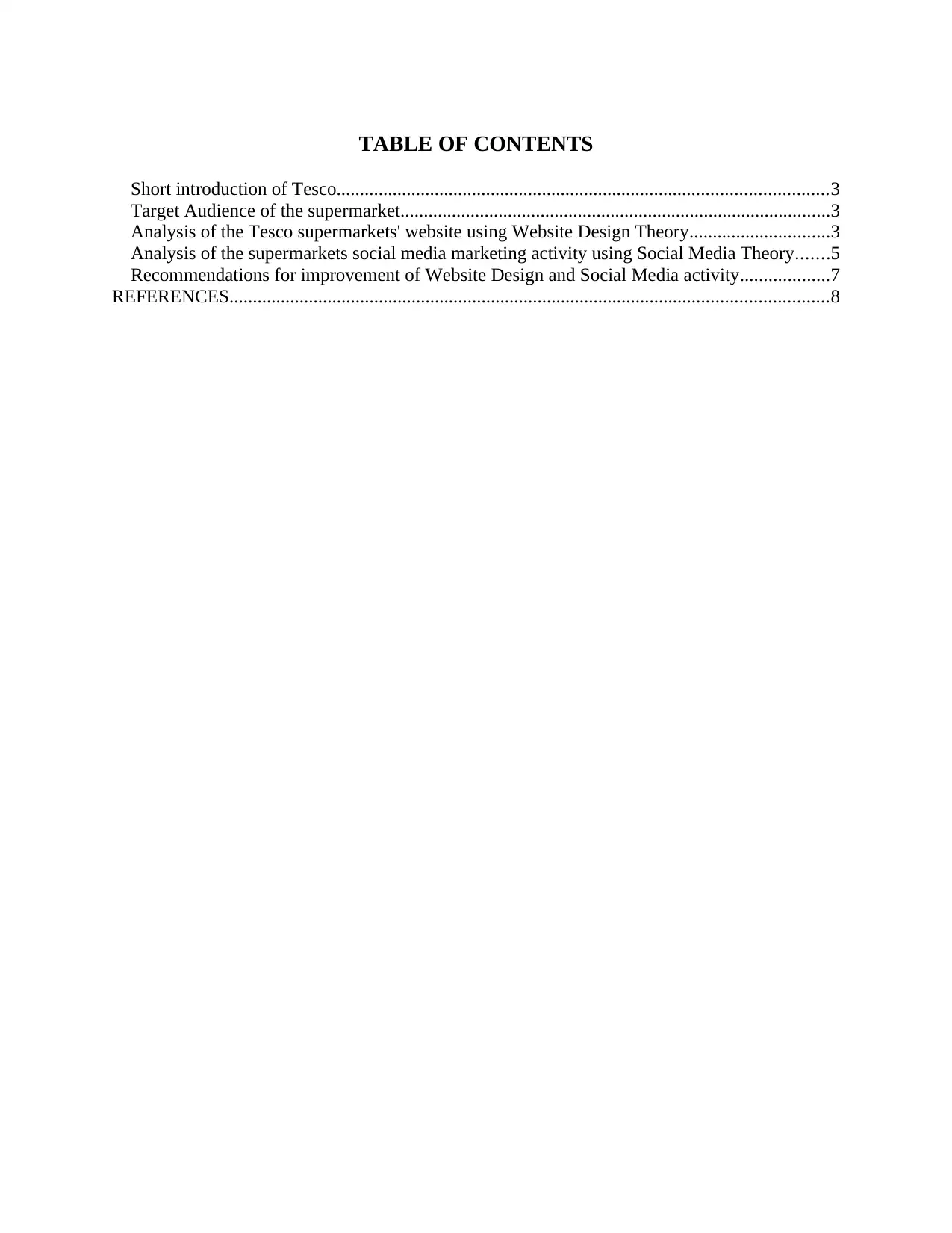
TABLE OF CONTENTS
Short introduction of Tesco.........................................................................................................3
Target Audience of the supermarket............................................................................................3
Analysis of the Tesco supermarkets' website using Website Design Theory..............................3
Analysis of the supermarkets social media marketing activity using Social Media Theory.......5
Recommendations for improvement of Website Design and Social Media activity...................7
REFERENCES................................................................................................................................8
Short introduction of Tesco.........................................................................................................3
Target Audience of the supermarket............................................................................................3
Analysis of the Tesco supermarkets' website using Website Design Theory..............................3
Analysis of the supermarkets social media marketing activity using Social Media Theory.......5
Recommendations for improvement of Website Design and Social Media activity...................7
REFERENCES................................................................................................................................8
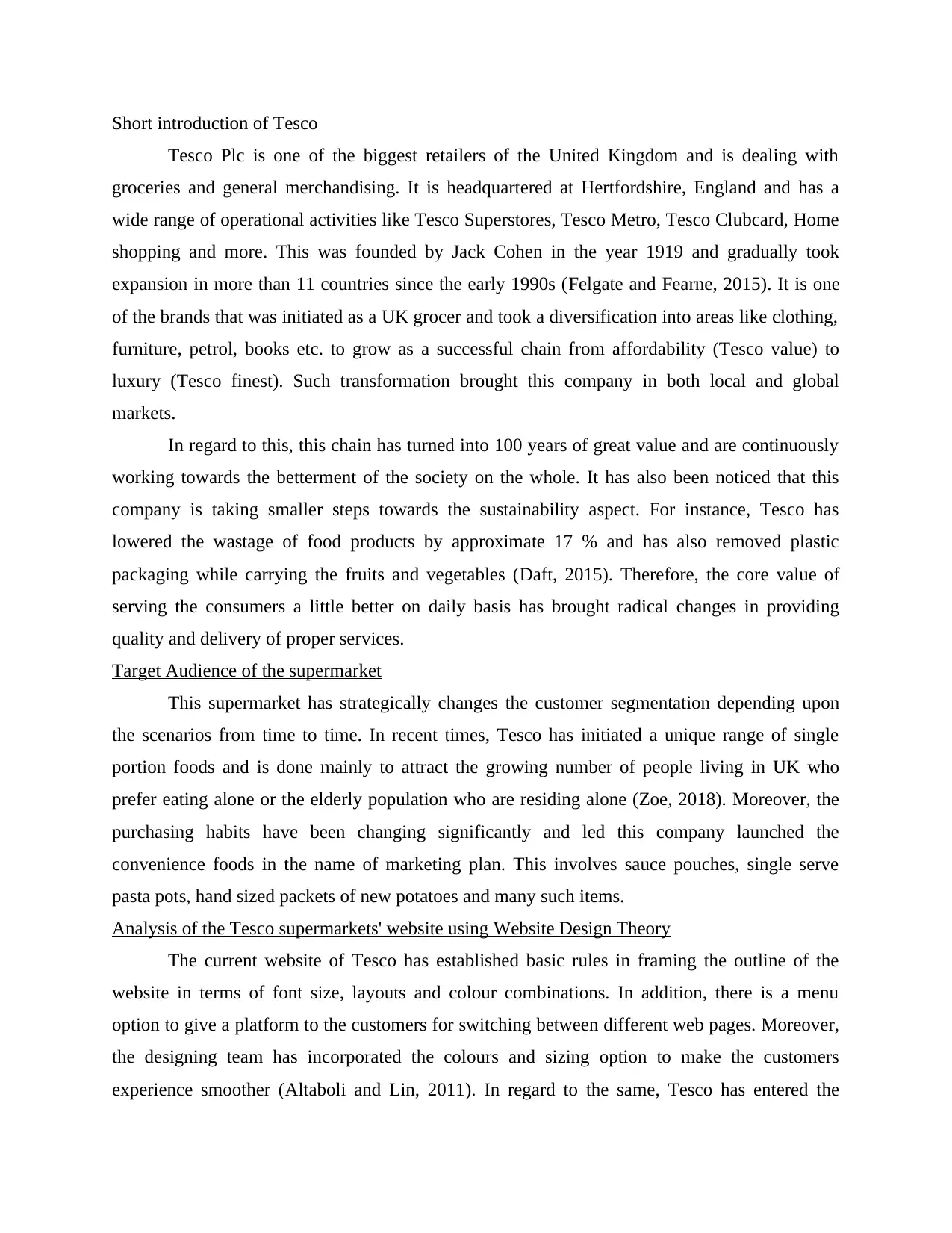
Short introduction of Tesco
Tesco Plc is one of the biggest retailers of the United Kingdom and is dealing with
groceries and general merchandising. It is headquartered at Hertfordshire, England and has a
wide range of operational activities like Tesco Superstores, Tesco Metro, Tesco Clubcard, Home
shopping and more. This was founded by Jack Cohen in the year 1919 and gradually took
expansion in more than 11 countries since the early 1990s (Felgate and Fearne, 2015). It is one
of the brands that was initiated as a UK grocer and took a diversification into areas like clothing,
furniture, petrol, books etc. to grow as a successful chain from affordability (Tesco value) to
luxury (Tesco finest). Such transformation brought this company in both local and global
markets.
In regard to this, this chain has turned into 100 years of great value and are continuously
working towards the betterment of the society on the whole. It has also been noticed that this
company is taking smaller steps towards the sustainability aspect. For instance, Tesco has
lowered the wastage of food products by approximate 17 % and has also removed plastic
packaging while carrying the fruits and vegetables (Daft, 2015). Therefore, the core value of
serving the consumers a little better on daily basis has brought radical changes in providing
quality and delivery of proper services.
Target Audience of the supermarket
This supermarket has strategically changes the customer segmentation depending upon
the scenarios from time to time. In recent times, Tesco has initiated a unique range of single
portion foods and is done mainly to attract the growing number of people living in UK who
prefer eating alone or the elderly population who are residing alone (Zoe, 2018). Moreover, the
purchasing habits have been changing significantly and led this company launched the
convenience foods in the name of marketing plan. This involves sauce pouches, single serve
pasta pots, hand sized packets of new potatoes and many such items.
Analysis of the Tesco supermarkets' website using Website Design Theory
The current website of Tesco has established basic rules in framing the outline of the
website in terms of font size, layouts and colour combinations. In addition, there is a menu
option to give a platform to the customers for switching between different web pages. Moreover,
the designing team has incorporated the colours and sizing option to make the customers
experience smoother (Altaboli and Lin, 2011). In regard to the same, Tesco has entered the
Tesco Plc is one of the biggest retailers of the United Kingdom and is dealing with
groceries and general merchandising. It is headquartered at Hertfordshire, England and has a
wide range of operational activities like Tesco Superstores, Tesco Metro, Tesco Clubcard, Home
shopping and more. This was founded by Jack Cohen in the year 1919 and gradually took
expansion in more than 11 countries since the early 1990s (Felgate and Fearne, 2015). It is one
of the brands that was initiated as a UK grocer and took a diversification into areas like clothing,
furniture, petrol, books etc. to grow as a successful chain from affordability (Tesco value) to
luxury (Tesco finest). Such transformation brought this company in both local and global
markets.
In regard to this, this chain has turned into 100 years of great value and are continuously
working towards the betterment of the society on the whole. It has also been noticed that this
company is taking smaller steps towards the sustainability aspect. For instance, Tesco has
lowered the wastage of food products by approximate 17 % and has also removed plastic
packaging while carrying the fruits and vegetables (Daft, 2015). Therefore, the core value of
serving the consumers a little better on daily basis has brought radical changes in providing
quality and delivery of proper services.
Target Audience of the supermarket
This supermarket has strategically changes the customer segmentation depending upon
the scenarios from time to time. In recent times, Tesco has initiated a unique range of single
portion foods and is done mainly to attract the growing number of people living in UK who
prefer eating alone or the elderly population who are residing alone (Zoe, 2018). Moreover, the
purchasing habits have been changing significantly and led this company launched the
convenience foods in the name of marketing plan. This involves sauce pouches, single serve
pasta pots, hand sized packets of new potatoes and many such items.
Analysis of the Tesco supermarkets' website using Website Design Theory
The current website of Tesco has established basic rules in framing the outline of the
website in terms of font size, layouts and colour combinations. In addition, there is a menu
option to give a platform to the customers for switching between different web pages. Moreover,
the designing team has incorporated the colours and sizing option to make the customers
experience smoother (Altaboli and Lin, 2011). In regard to the same, Tesco has entered the
⊘ This is a preview!⊘
Do you want full access?
Subscribe today to unlock all pages.

Trusted by 1+ million students worldwide
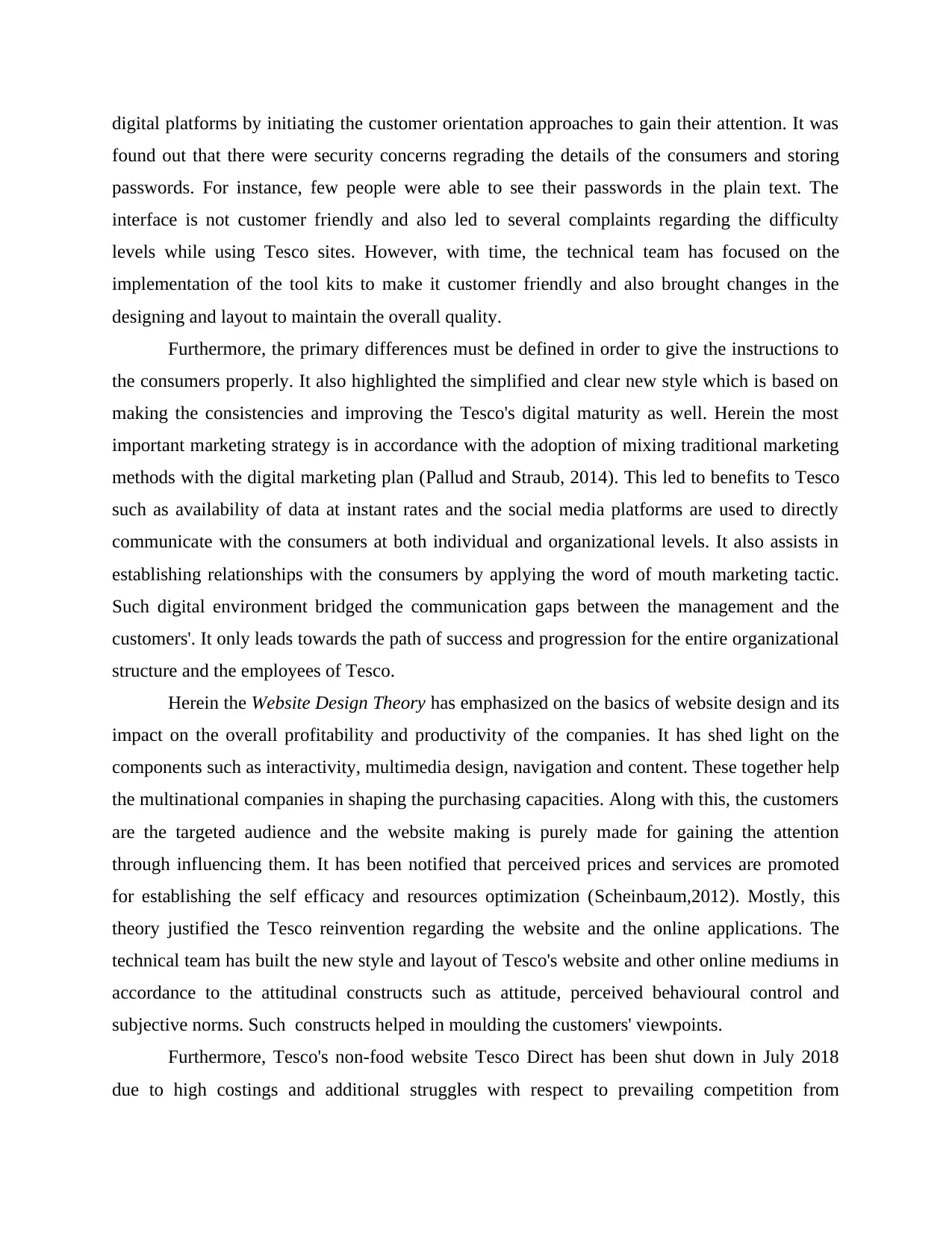
digital platforms by initiating the customer orientation approaches to gain their attention. It was
found out that there were security concerns regrading the details of the consumers and storing
passwords. For instance, few people were able to see their passwords in the plain text. The
interface is not customer friendly and also led to several complaints regarding the difficulty
levels while using Tesco sites. However, with time, the technical team has focused on the
implementation of the tool kits to make it customer friendly and also brought changes in the
designing and layout to maintain the overall quality.
Furthermore, the primary differences must be defined in order to give the instructions to
the consumers properly. It also highlighted the simplified and clear new style which is based on
making the consistencies and improving the Tesco's digital maturity as well. Herein the most
important marketing strategy is in accordance with the adoption of mixing traditional marketing
methods with the digital marketing plan (Pallud and Straub, 2014). This led to benefits to Tesco
such as availability of data at instant rates and the social media platforms are used to directly
communicate with the consumers at both individual and organizational levels. It also assists in
establishing relationships with the consumers by applying the word of mouth marketing tactic.
Such digital environment bridged the communication gaps between the management and the
customers'. It only leads towards the path of success and progression for the entire organizational
structure and the employees of Tesco.
Herein the Website Design Theory has emphasized on the basics of website design and its
impact on the overall profitability and productivity of the companies. It has shed light on the
components such as interactivity, multimedia design, navigation and content. These together help
the multinational companies in shaping the purchasing capacities. Along with this, the customers
are the targeted audience and the website making is purely made for gaining the attention
through influencing them. It has been notified that perceived prices and services are promoted
for establishing the self efficacy and resources optimization (Scheinbaum,2012). Mostly, this
theory justified the Tesco reinvention regarding the website and the online applications. The
technical team has built the new style and layout of Tesco's website and other online mediums in
accordance to the attitudinal constructs such as attitude, perceived behavioural control and
subjective norms. Such constructs helped in moulding the customers' viewpoints.
Furthermore, Tesco's non-food website Tesco Direct has been shut down in July 2018
due to high costings and additional struggles with respect to prevailing competition from
found out that there were security concerns regrading the details of the consumers and storing
passwords. For instance, few people were able to see their passwords in the plain text. The
interface is not customer friendly and also led to several complaints regarding the difficulty
levels while using Tesco sites. However, with time, the technical team has focused on the
implementation of the tool kits to make it customer friendly and also brought changes in the
designing and layout to maintain the overall quality.
Furthermore, the primary differences must be defined in order to give the instructions to
the consumers properly. It also highlighted the simplified and clear new style which is based on
making the consistencies and improving the Tesco's digital maturity as well. Herein the most
important marketing strategy is in accordance with the adoption of mixing traditional marketing
methods with the digital marketing plan (Pallud and Straub, 2014). This led to benefits to Tesco
such as availability of data at instant rates and the social media platforms are used to directly
communicate with the consumers at both individual and organizational levels. It also assists in
establishing relationships with the consumers by applying the word of mouth marketing tactic.
Such digital environment bridged the communication gaps between the management and the
customers'. It only leads towards the path of success and progression for the entire organizational
structure and the employees of Tesco.
Herein the Website Design Theory has emphasized on the basics of website design and its
impact on the overall profitability and productivity of the companies. It has shed light on the
components such as interactivity, multimedia design, navigation and content. These together help
the multinational companies in shaping the purchasing capacities. Along with this, the customers
are the targeted audience and the website making is purely made for gaining the attention
through influencing them. It has been notified that perceived prices and services are promoted
for establishing the self efficacy and resources optimization (Scheinbaum,2012). Mostly, this
theory justified the Tesco reinvention regarding the website and the online applications. The
technical team has built the new style and layout of Tesco's website and other online mediums in
accordance to the attitudinal constructs such as attitude, perceived behavioural control and
subjective norms. Such constructs helped in moulding the customers' viewpoints.
Furthermore, Tesco's non-food website Tesco Direct has been shut down in July 2018
due to high costings and additional struggles with respect to prevailing competition from
Paraphrase This Document
Need a fresh take? Get an instant paraphrase of this document with our AI Paraphraser
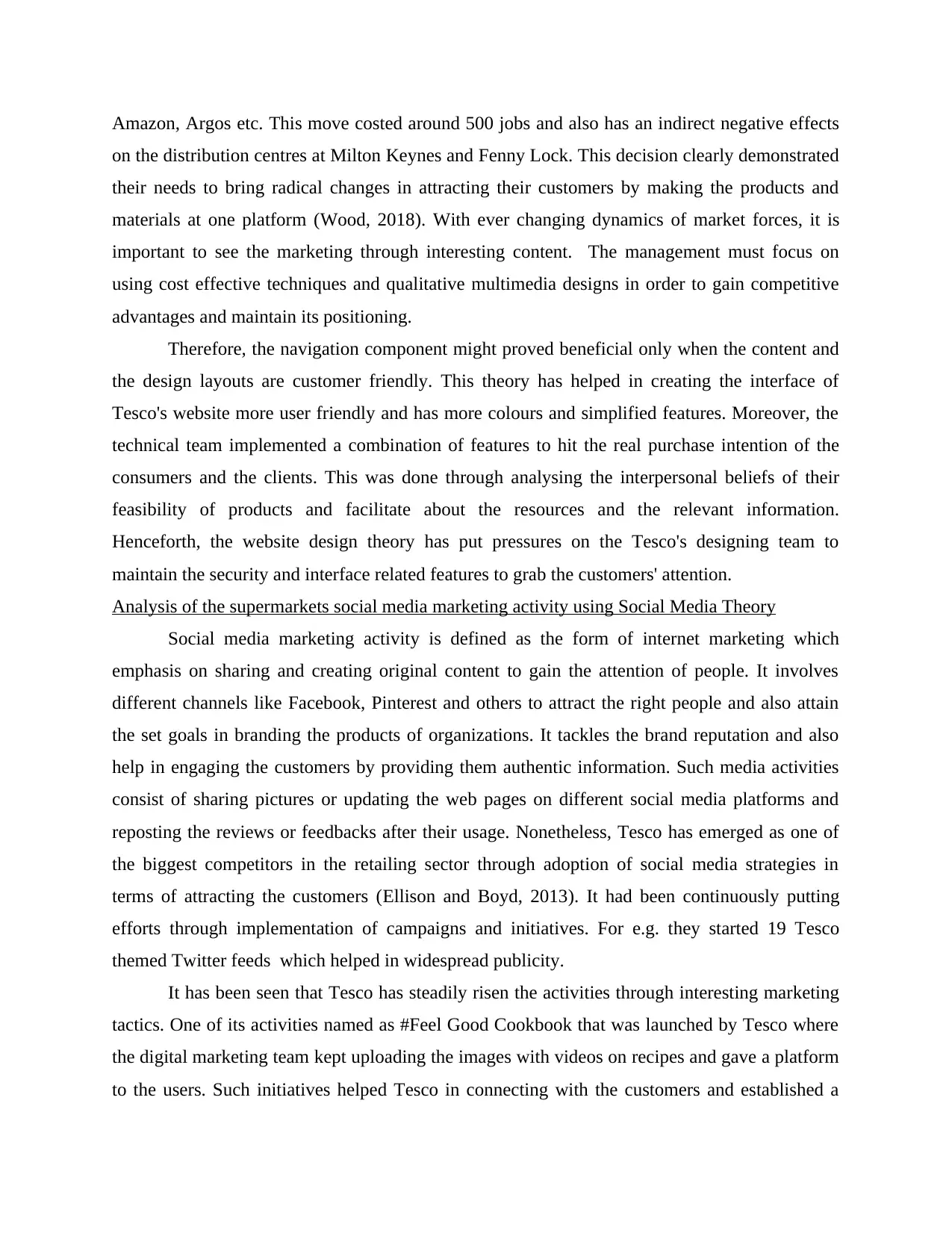
Amazon, Argos etc. This move costed around 500 jobs and also has an indirect negative effects
on the distribution centres at Milton Keynes and Fenny Lock. This decision clearly demonstrated
their needs to bring radical changes in attracting their customers by making the products and
materials at one platform (Wood, 2018). With ever changing dynamics of market forces, it is
important to see the marketing through interesting content. The management must focus on
using cost effective techniques and qualitative multimedia designs in order to gain competitive
advantages and maintain its positioning.
Therefore, the navigation component might proved beneficial only when the content and
the design layouts are customer friendly. This theory has helped in creating the interface of
Tesco's website more user friendly and has more colours and simplified features. Moreover, the
technical team implemented a combination of features to hit the real purchase intention of the
consumers and the clients. This was done through analysing the interpersonal beliefs of their
feasibility of products and facilitate about the resources and the relevant information.
Henceforth, the website design theory has put pressures on the Tesco's designing team to
maintain the security and interface related features to grab the customers' attention.
Analysis of the supermarkets social media marketing activity using Social Media Theory
Social media marketing activity is defined as the form of internet marketing which
emphasis on sharing and creating original content to gain the attention of people. It involves
different channels like Facebook, Pinterest and others to attract the right people and also attain
the set goals in branding the products of organizations. It tackles the brand reputation and also
help in engaging the customers by providing them authentic information. Such media activities
consist of sharing pictures or updating the web pages on different social media platforms and
reposting the reviews or feedbacks after their usage. Nonetheless, Tesco has emerged as one of
the biggest competitors in the retailing sector through adoption of social media strategies in
terms of attracting the customers (Ellison and Boyd, 2013). It had been continuously putting
efforts through implementation of campaigns and initiatives. For e.g. they started 19 Tesco
themed Twitter feeds which helped in widespread publicity.
It has been seen that Tesco has steadily risen the activities through interesting marketing
tactics. One of its activities named as #Feel Good Cookbook that was launched by Tesco where
the digital marketing team kept uploading the images with videos on recipes and gave a platform
to the users. Such initiatives helped Tesco in connecting with the customers and established a
on the distribution centres at Milton Keynes and Fenny Lock. This decision clearly demonstrated
their needs to bring radical changes in attracting their customers by making the products and
materials at one platform (Wood, 2018). With ever changing dynamics of market forces, it is
important to see the marketing through interesting content. The management must focus on
using cost effective techniques and qualitative multimedia designs in order to gain competitive
advantages and maintain its positioning.
Therefore, the navigation component might proved beneficial only when the content and
the design layouts are customer friendly. This theory has helped in creating the interface of
Tesco's website more user friendly and has more colours and simplified features. Moreover, the
technical team implemented a combination of features to hit the real purchase intention of the
consumers and the clients. This was done through analysing the interpersonal beliefs of their
feasibility of products and facilitate about the resources and the relevant information.
Henceforth, the website design theory has put pressures on the Tesco's designing team to
maintain the security and interface related features to grab the customers' attention.
Analysis of the supermarkets social media marketing activity using Social Media Theory
Social media marketing activity is defined as the form of internet marketing which
emphasis on sharing and creating original content to gain the attention of people. It involves
different channels like Facebook, Pinterest and others to attract the right people and also attain
the set goals in branding the products of organizations. It tackles the brand reputation and also
help in engaging the customers by providing them authentic information. Such media activities
consist of sharing pictures or updating the web pages on different social media platforms and
reposting the reviews or feedbacks after their usage. Nonetheless, Tesco has emerged as one of
the biggest competitors in the retailing sector through adoption of social media strategies in
terms of attracting the customers (Ellison and Boyd, 2013). It had been continuously putting
efforts through implementation of campaigns and initiatives. For e.g. they started 19 Tesco
themed Twitter feeds which helped in widespread publicity.
It has been seen that Tesco has steadily risen the activities through interesting marketing
tactics. One of its activities named as #Feel Good Cookbook that was launched by Tesco where
the digital marketing team kept uploading the images with videos on recipes and gave a platform
to the users. Such initiatives helped Tesco in connecting with the customers and established a
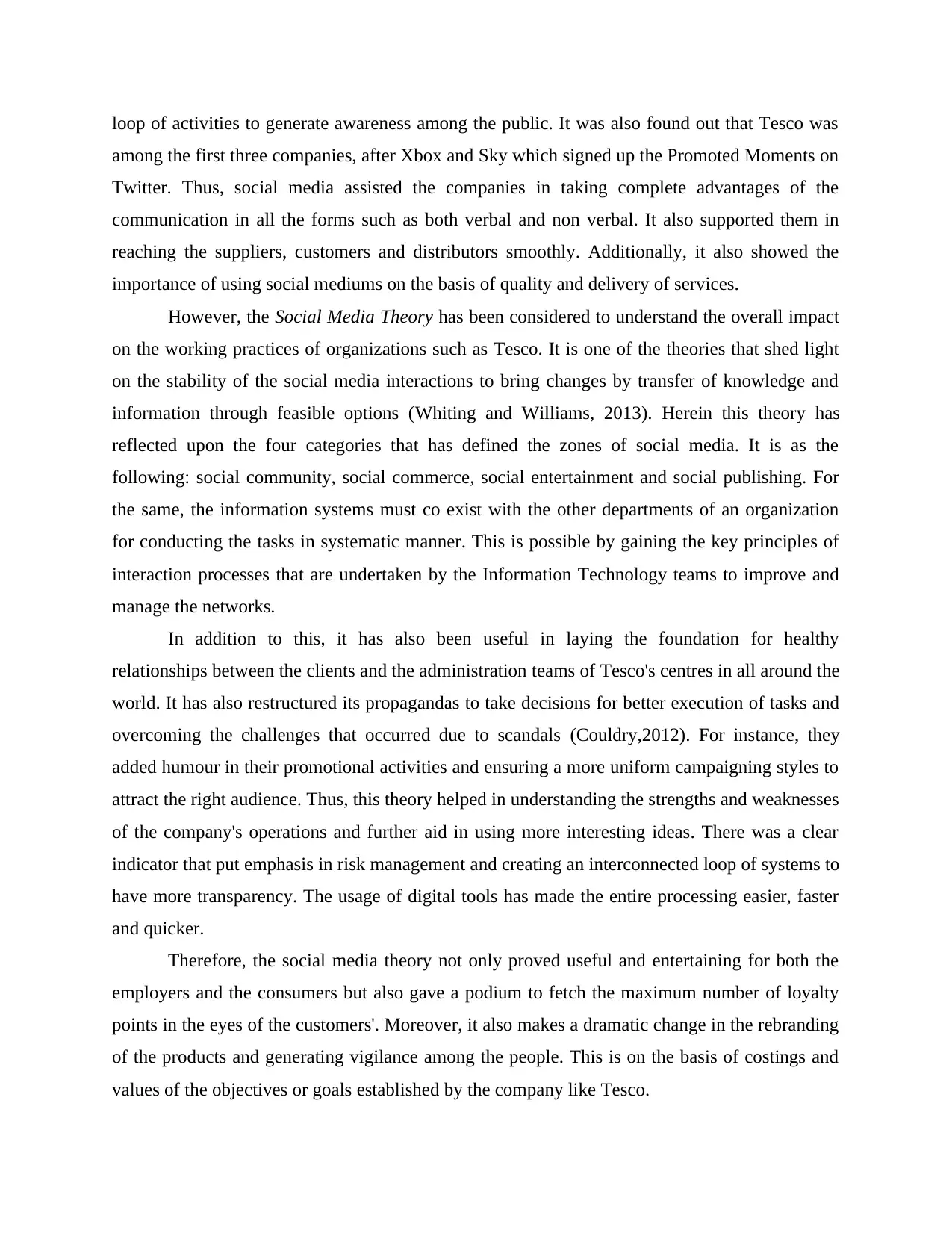
loop of activities to generate awareness among the public. It was also found out that Tesco was
among the first three companies, after Xbox and Sky which signed up the Promoted Moments on
Twitter. Thus, social media assisted the companies in taking complete advantages of the
communication in all the forms such as both verbal and non verbal. It also supported them in
reaching the suppliers, customers and distributors smoothly. Additionally, it also showed the
importance of using social mediums on the basis of quality and delivery of services.
However, the Social Media Theory has been considered to understand the overall impact
on the working practices of organizations such as Tesco. It is one of the theories that shed light
on the stability of the social media interactions to bring changes by transfer of knowledge and
information through feasible options (Whiting and Williams, 2013). Herein this theory has
reflected upon the four categories that has defined the zones of social media. It is as the
following: social community, social commerce, social entertainment and social publishing. For
the same, the information systems must co exist with the other departments of an organization
for conducting the tasks in systematic manner. This is possible by gaining the key principles of
interaction processes that are undertaken by the Information Technology teams to improve and
manage the networks.
In addition to this, it has also been useful in laying the foundation for healthy
relationships between the clients and the administration teams of Tesco's centres in all around the
world. It has also restructured its propagandas to take decisions for better execution of tasks and
overcoming the challenges that occurred due to scandals (Couldry,2012). For instance, they
added humour in their promotional activities and ensuring a more uniform campaigning styles to
attract the right audience. Thus, this theory helped in understanding the strengths and weaknesses
of the company's operations and further aid in using more interesting ideas. There was a clear
indicator that put emphasis in risk management and creating an interconnected loop of systems to
have more transparency. The usage of digital tools has made the entire processing easier, faster
and quicker.
Therefore, the social media theory not only proved useful and entertaining for both the
employers and the consumers but also gave a podium to fetch the maximum number of loyalty
points in the eyes of the customers'. Moreover, it also makes a dramatic change in the rebranding
of the products and generating vigilance among the people. This is on the basis of costings and
values of the objectives or goals established by the company like Tesco.
among the first three companies, after Xbox and Sky which signed up the Promoted Moments on
Twitter. Thus, social media assisted the companies in taking complete advantages of the
communication in all the forms such as both verbal and non verbal. It also supported them in
reaching the suppliers, customers and distributors smoothly. Additionally, it also showed the
importance of using social mediums on the basis of quality and delivery of services.
However, the Social Media Theory has been considered to understand the overall impact
on the working practices of organizations such as Tesco. It is one of the theories that shed light
on the stability of the social media interactions to bring changes by transfer of knowledge and
information through feasible options (Whiting and Williams, 2013). Herein this theory has
reflected upon the four categories that has defined the zones of social media. It is as the
following: social community, social commerce, social entertainment and social publishing. For
the same, the information systems must co exist with the other departments of an organization
for conducting the tasks in systematic manner. This is possible by gaining the key principles of
interaction processes that are undertaken by the Information Technology teams to improve and
manage the networks.
In addition to this, it has also been useful in laying the foundation for healthy
relationships between the clients and the administration teams of Tesco's centres in all around the
world. It has also restructured its propagandas to take decisions for better execution of tasks and
overcoming the challenges that occurred due to scandals (Couldry,2012). For instance, they
added humour in their promotional activities and ensuring a more uniform campaigning styles to
attract the right audience. Thus, this theory helped in understanding the strengths and weaknesses
of the company's operations and further aid in using more interesting ideas. There was a clear
indicator that put emphasis in risk management and creating an interconnected loop of systems to
have more transparency. The usage of digital tools has made the entire processing easier, faster
and quicker.
Therefore, the social media theory not only proved useful and entertaining for both the
employers and the consumers but also gave a podium to fetch the maximum number of loyalty
points in the eyes of the customers'. Moreover, it also makes a dramatic change in the rebranding
of the products and generating vigilance among the people. This is on the basis of costings and
values of the objectives or goals established by the company like Tesco.
⊘ This is a preview!⊘
Do you want full access?
Subscribe today to unlock all pages.

Trusted by 1+ million students worldwide
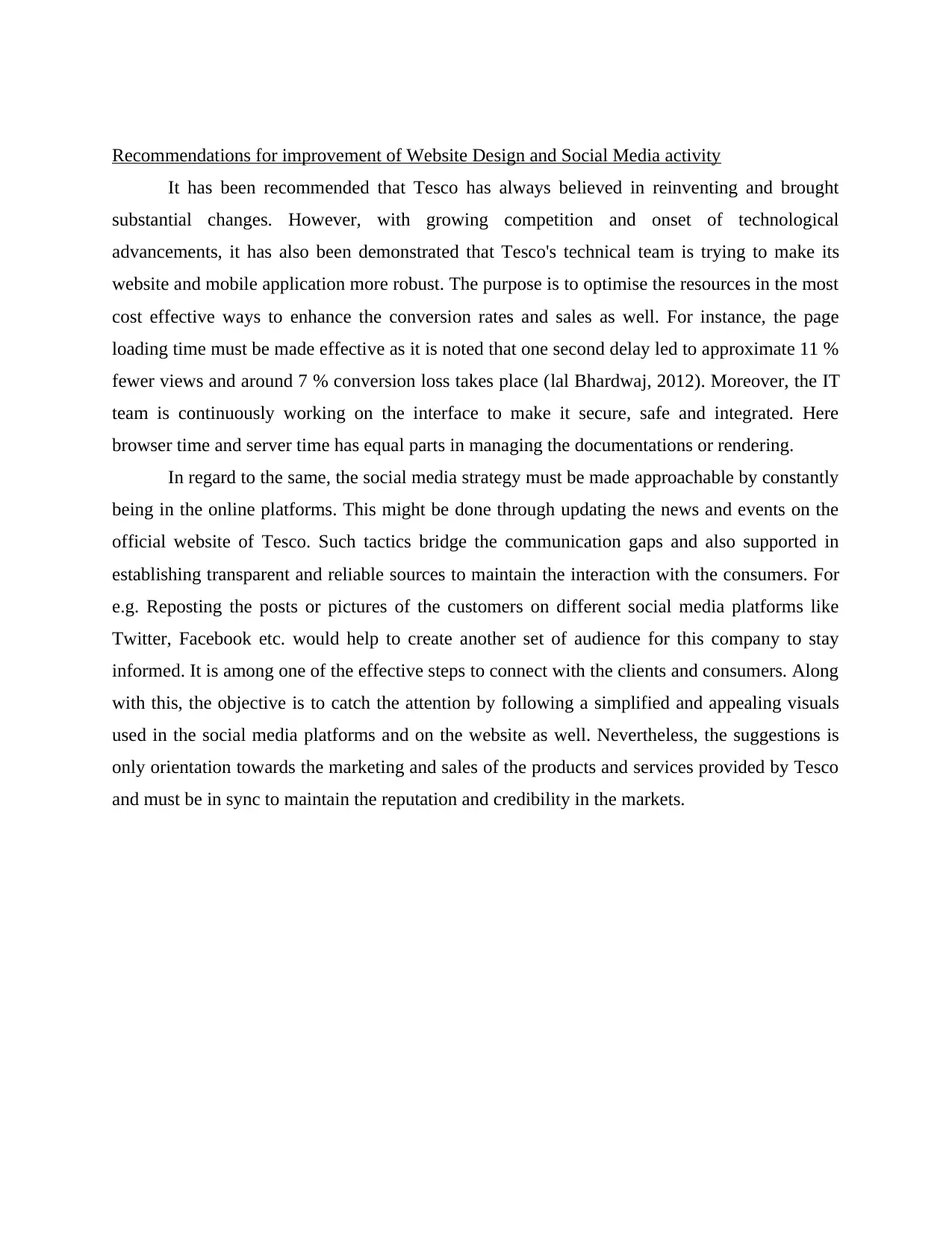
Recommendations for improvement of Website Design and Social Media activity
It has been recommended that Tesco has always believed in reinventing and brought
substantial changes. However, with growing competition and onset of technological
advancements, it has also been demonstrated that Tesco's technical team is trying to make its
website and mobile application more robust. The purpose is to optimise the resources in the most
cost effective ways to enhance the conversion rates and sales as well. For instance, the page
loading time must be made effective as it is noted that one second delay led to approximate 11 %
fewer views and around 7 % conversion loss takes place (lal Bhardwaj, 2012). Moreover, the IT
team is continuously working on the interface to make it secure, safe and integrated. Here
browser time and server time has equal parts in managing the documentations or rendering.
In regard to the same, the social media strategy must be made approachable by constantly
being in the online platforms. This might be done through updating the news and events on the
official website of Tesco. Such tactics bridge the communication gaps and also supported in
establishing transparent and reliable sources to maintain the interaction with the consumers. For
e.g. Reposting the posts or pictures of the customers on different social media platforms like
Twitter, Facebook etc. would help to create another set of audience for this company to stay
informed. It is among one of the effective steps to connect with the clients and consumers. Along
with this, the objective is to catch the attention by following a simplified and appealing visuals
used in the social media platforms and on the website as well. Nevertheless, the suggestions is
only orientation towards the marketing and sales of the products and services provided by Tesco
and must be in sync to maintain the reputation and credibility in the markets.
It has been recommended that Tesco has always believed in reinventing and brought
substantial changes. However, with growing competition and onset of technological
advancements, it has also been demonstrated that Tesco's technical team is trying to make its
website and mobile application more robust. The purpose is to optimise the resources in the most
cost effective ways to enhance the conversion rates and sales as well. For instance, the page
loading time must be made effective as it is noted that one second delay led to approximate 11 %
fewer views and around 7 % conversion loss takes place (lal Bhardwaj, 2012). Moreover, the IT
team is continuously working on the interface to make it secure, safe and integrated. Here
browser time and server time has equal parts in managing the documentations or rendering.
In regard to the same, the social media strategy must be made approachable by constantly
being in the online platforms. This might be done through updating the news and events on the
official website of Tesco. Such tactics bridge the communication gaps and also supported in
establishing transparent and reliable sources to maintain the interaction with the consumers. For
e.g. Reposting the posts or pictures of the customers on different social media platforms like
Twitter, Facebook etc. would help to create another set of audience for this company to stay
informed. It is among one of the effective steps to connect with the clients and consumers. Along
with this, the objective is to catch the attention by following a simplified and appealing visuals
used in the social media platforms and on the website as well. Nevertheless, the suggestions is
only orientation towards the marketing and sales of the products and services provided by Tesco
and must be in sync to maintain the reputation and credibility in the markets.
Paraphrase This Document
Need a fresh take? Get an instant paraphrase of this document with our AI Paraphraser
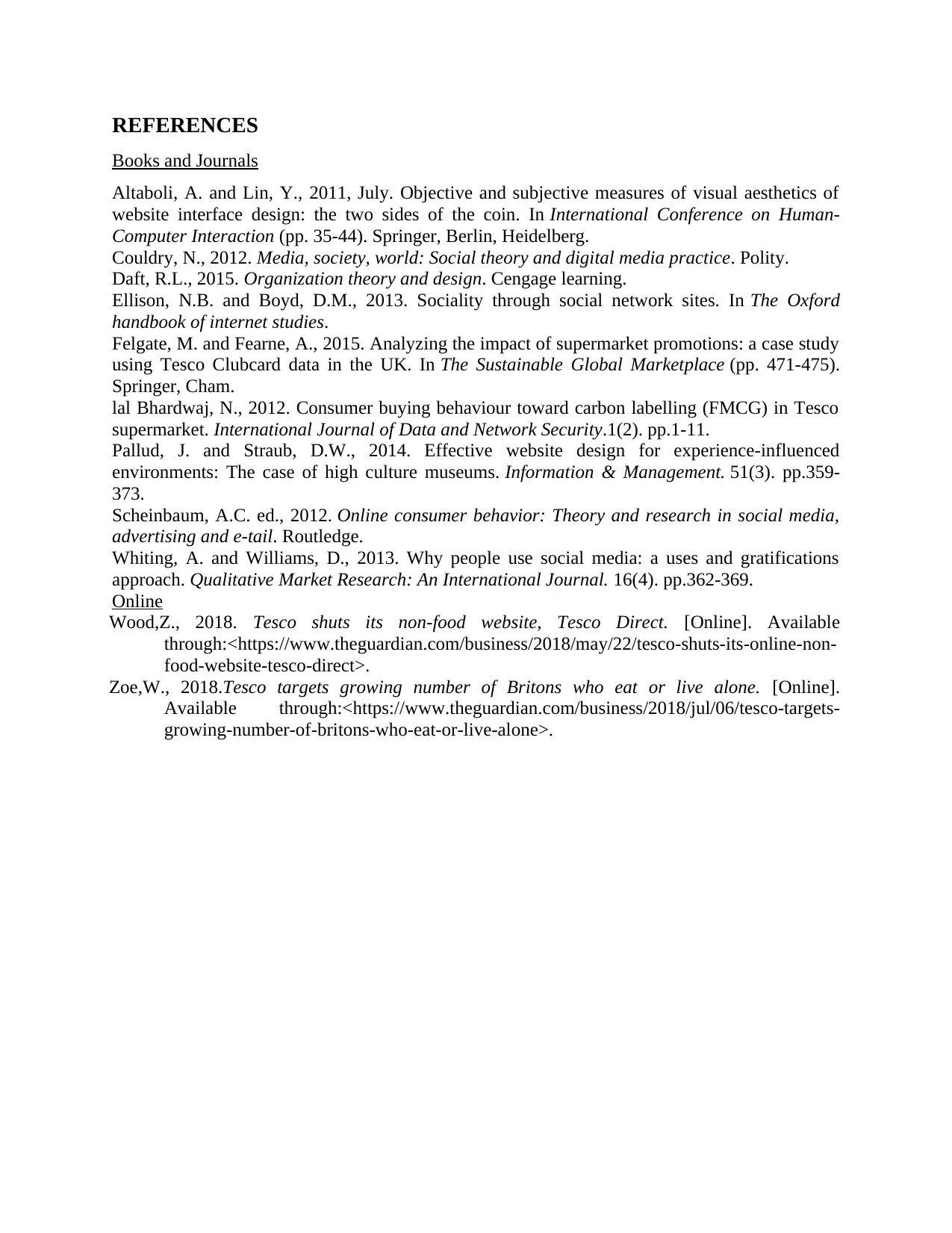
REFERENCES
Books and Journals
Altaboli, A. and Lin, Y., 2011, July. Objective and subjective measures of visual aesthetics of
website interface design: the two sides of the coin. In International Conference on Human-
Computer Interaction (pp. 35-44). Springer, Berlin, Heidelberg.
Couldry, N., 2012. Media, society, world: Social theory and digital media practice. Polity.
Daft, R.L., 2015. Organization theory and design. Cengage learning.
Ellison, N.B. and Boyd, D.M., 2013. Sociality through social network sites. In The Oxford
handbook of internet studies.
Felgate, M. and Fearne, A., 2015. Analyzing the impact of supermarket promotions: a case study
using Tesco Clubcard data in the UK. In The Sustainable Global Marketplace (pp. 471-475).
Springer, Cham.
lal Bhardwaj, N., 2012. Consumer buying behaviour toward carbon labelling (FMCG) in Tesco
supermarket. International Journal of Data and Network Security.1(2). pp.1-11.
Pallud, J. and Straub, D.W., 2014. Effective website design for experience-influenced
environments: The case of high culture museums. Information & Management. 51(3). pp.359-
373.
Scheinbaum, A.C. ed., 2012. Online consumer behavior: Theory and research in social media,
advertising and e-tail. Routledge.
Whiting, A. and Williams, D., 2013. Why people use social media: a uses and gratifications
approach. Qualitative Market Research: An International Journal. 16(4). pp.362-369.
Online
Wood,Z., 2018. Tesco shuts its non-food website, Tesco Direct. [Online]. Available
through:<https://www.theguardian.com/business/2018/may/22/tesco-shuts-its-online-non-
food-website-tesco-direct>.
Zoe,W., 2018.Tesco targets growing number of Britons who eat or live alone. [Online].
Available through:<https://www.theguardian.com/business/2018/jul/06/tesco-targets-
growing-number-of-britons-who-eat-or-live-alone>.
Books and Journals
Altaboli, A. and Lin, Y., 2011, July. Objective and subjective measures of visual aesthetics of
website interface design: the two sides of the coin. In International Conference on Human-
Computer Interaction (pp. 35-44). Springer, Berlin, Heidelberg.
Couldry, N., 2012. Media, society, world: Social theory and digital media practice. Polity.
Daft, R.L., 2015. Organization theory and design. Cengage learning.
Ellison, N.B. and Boyd, D.M., 2013. Sociality through social network sites. In The Oxford
handbook of internet studies.
Felgate, M. and Fearne, A., 2015. Analyzing the impact of supermarket promotions: a case study
using Tesco Clubcard data in the UK. In The Sustainable Global Marketplace (pp. 471-475).
Springer, Cham.
lal Bhardwaj, N., 2012. Consumer buying behaviour toward carbon labelling (FMCG) in Tesco
supermarket. International Journal of Data and Network Security.1(2). pp.1-11.
Pallud, J. and Straub, D.W., 2014. Effective website design for experience-influenced
environments: The case of high culture museums. Information & Management. 51(3). pp.359-
373.
Scheinbaum, A.C. ed., 2012. Online consumer behavior: Theory and research in social media,
advertising and e-tail. Routledge.
Whiting, A. and Williams, D., 2013. Why people use social media: a uses and gratifications
approach. Qualitative Market Research: An International Journal. 16(4). pp.362-369.
Online
Wood,Z., 2018. Tesco shuts its non-food website, Tesco Direct. [Online]. Available
through:<https://www.theguardian.com/business/2018/may/22/tesco-shuts-its-online-non-
food-website-tesco-direct>.
Zoe,W., 2018.Tesco targets growing number of Britons who eat or live alone. [Online].
Available through:<https://www.theguardian.com/business/2018/jul/06/tesco-targets-
growing-number-of-britons-who-eat-or-live-alone>.
1 out of 8
Related Documents
Your All-in-One AI-Powered Toolkit for Academic Success.
+13062052269
info@desklib.com
Available 24*7 on WhatsApp / Email
![[object Object]](/_next/static/media/star-bottom.7253800d.svg)
Unlock your academic potential
Copyright © 2020–2025 A2Z Services. All Rights Reserved. Developed and managed by ZUCOL.


